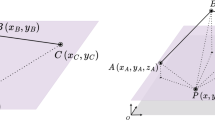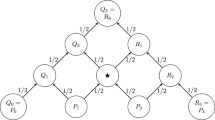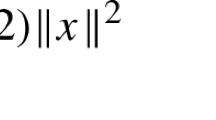Abstract
Fourier series are usually employed to describe closed or open, 2D or 3D outlines of biological samples. Landmark-based morphometric methods are widely used in the analysis of 3D surfaces. There are few investigations on the representation and morphometric analysis of 3D biological sample surfaces with methods relating to Fourier series. In this paper, we firstly extend discrete cosine transform (DCT), a Fourier-related method classically used to describe 2D open curves, but here to 3D surfaces. Surfaces are transformed into 3D curves with a path connecting all points. The path can be determined manually by an analyst or by algorithms. Before being represented with DCT, non-shape effects should be eliminated. A strategy to improve the selection of coefficients to approximate surfaces is also presented. As a result, the mathematical homology of the coefficients is preserved while fast convergence of the approximation is ensured. Three 3D surface examples are transformed into 3D curves and represented with DCT. The first example is four groups of 120 simulated surfaces generated with equations, and the other two examples are 3D surfaces extracted from aligned 3D human skulls with four types of diagnoses of coronal craniosynostosis. Principal component analysis, one-way analysis of similarity, and one-way permutational multivariate analysis of variance are utilized to analyze the coefficients obtained. The results of statistical analyses suggest that DCT is an effective and stable tool in describing 3D surfaces.

















Similar content being viewed by others
Data Availability
The data and code that support this study are available in the supplementary materials.
References
Abdi, H., & Williams, L. J. (2010). Principal component analysis. Wiley Interdisciplinary Reviews: Computational Statistics, 2(4), 433–459.
Agbolade, O., Nazri, A., Yaakob, R., Abd Ghani, A. A., & Cheah, Y. K. (2020). Landmark-based homologous multi-point warping approach to 3D facial recognition using multiple datasets. PeerJ Computer Science, 6, e249.
Alhusain, L., & Hafez, A. M. (2018). Nonparametric approaches for population structure analysis. Human Genomics, 12(1), 25.
Anderson, M. J. (2001). A new method for non-parametric multivariate analysis of variance. Austral Ecology, 26(1), 32–46.
Bookstein, F. L. (1997a). Landmark methods for forms without landmarks: Morphometrics of group differences in outline shape. Medical Image Analysis, 1(3), 225–243.
Bookstein, F. L. (1997). Morphometric tools for landmark data: Geometry and biology. Cambridge University Press.
Bookstein, F. L. (2019). Pathologies of between-groups principal components analysis in geometric morphometrics. Evolutionary Biology, 46(4), 271–302.
Breno, M., Leirs, H., & Van Dongen, S. (2011). Traditional and geometric morphometrics for studying skull morphology during growth in Mastomys natalensis (Rodentia: Muridae). Journal of Mammalogy, 92(6), 1395–1406.
Cardini, A. (2020). Less tautology, more biology? A comment on “high-density” morphometrics. Zoomorphology, 139(4), 513–529.
Cardini, A., O’Higgins, P., & Rohlf, F. J. (2019). Seeing distinct groups where there are none: Spurious patterns from between-group PCA. Evolutionary Biology, 46(4), 303–316.
Clarke, K. R. (1993). Non-parametric multivariate analyses of changes in community structure. Australian Journal of Ecology, 18(1), 117–143.
Crampton, J. S. (1995). Elliptic Fourier shape analysis of fossil bivalves: Some practical considerations. Lethaia, 28(2), 179–186.
Dommergues, C. H., Dommergues, J.-L., & Verrecchia, E. P. (2007). The discrete cosine transform, a Fourier-related method for morphometric analysis of open contours. Mathematical Geology, 39(8), 749–763.
Ege, Y. C., Foth, C., Baum, D., et al. (2020). Adapting spherical-harmonics-based geometric morphometrics (SPHARM) for 3D images containing large cavity openings using ambient occlusion: A study with hermit crab claw shape variability. Zoomorphology, 139, 421–432.
Ferson, S., Rohlf, F. J., & Koehn, R. K. (1985). Measuring shape variation of two-dimensional outlines. Systematic Biology, 34(1), 59–68.
Gioan, E., Sol, K., & Subsol, G. (2012). A combinatorial method for 3D landmark-based morphometry: Application to the study of coronal craniosynostosis. International conference on medical image computing and computer-assisted intervention (pp. 533–541). Springer.
Goswami, A., Watanabe, A., Felice, R. N., Bardua, C., Fabre, A.-C., & Polly, P. D. (2019). High-density morphometric analysis of shape and integration: The good, the bad, and the not-really-a-problem. Integrative and Comparative Biology, 59(3), 669–683.
Gower, J. C. (1975). Generalized procrustes analysis. Psychometrika, 40(1), 33–51.
Gunz, P., & Mitteroecker, P. (2013). Semilandmarks: A method for quantifying curves and surfaces. Hystrix, The Italian Journal of Mammalogy, 24(1), 103–109.
Hammer, Ø., Harper, D. A., & Ryan, P. D. (2001). PAST: Paleontological statistics software package for education and data analysis. Palaeontologia Electronica, 4(1), 9.
Heuzé, Y., Martínez-Abadías, N., Stella, J. M., Senders, C. W., Boyadjiev, S. A., Lo, L. J., & Richtsmeier, J. T. (2012). Unilateral and bilateral expression of a quantitative trait: Asymmetry and symmetry in coronal craniosynostosis. Journal of Experimental Zoology Part B: Molecular and Developmental Evolution, 318(2), 109–122.
Kuhl, F. P., & Giardina, C. R. (1982). Elliptic Fourier features of a closed contour. Computer Graphics and Image Processing, 18(3), 236–258.
Lee, E. T. (1989). Choosing nodes in parametric curve interpolation. Computer-Aided Design, 21(6), 363–370.
Lestrel, P. E. (1997). Fourier descriptors and their applications in biology. Cambridge University Press.
MacLeod, N. (2017). Morphometrics: History, development methods and prospects. Zoological Systematics, 42, 4–33.
Preston, S. (2008). Shape. Retrieved 30 July, 2021, from https://www.maths.nottingham.ac.uk/plp/pmzspp/shape.php.
Rohlf, F. J., & Marcus, L. F. (1993). A revolution morphometrics. Trends in Ecology & Evolution, 8(4), 129–132.
Slice, D. E. (2006). Modern morphometrics in physical anthropology. Springer.
Söderkvist, I. (1999). Introductory overview of surface reconstruction methods. Technical report 1999-10, Department of Mathematics, University of Technology, Lulea, Sweden. Retrieved 30 July, 2012, from http://www.sm.luth.se/inge/publications/surfrec.ps.
Tharwat, A., Gaber, T., Ibrahim, A., & Hassanien, A. E. (2017). Linear discriminant analysis: A detailed tutorial. AI Communications, 30(2), 169–190.
Vranic, D., & Saupe, D. (2001). 3D shape descriptor based on 3D Fourier transform (pp. 271–274). EURASIP.
Webster, M., & Sheets, H. D. (2010). A practical introduction to landmark-based geometric morphometrics. The Paleontological Society Papers, 16, 163–188.
Zhou, S., Li, B., & Nie, H. (2021). Parametric fitting and morphometric analysis of 3D open curves based on discrete cosine transform. Zoomorphology, 140(2), 301–314. https://doi.org/10.1007/s00435-021-00520-w
Acknowledgements
We want to acknowledge Emeric Gioan for sharing the 3D skull data of different diagnoses. This work is supported by the National Natural Science Foundation of China under Grant No. 51805080.
Author information
Authors and Affiliations
Contributions
BL: conceptualization, methodology, validation, resources, writing—original draft, writing—review & editing, visualization, supervision, funding acquisition. SZ: methodology, software, investigation, writing—original draft, writing—review & editing, visualization. HN: software, investigation, data curation, writing—original draft, writing—review & editing, visualization.
Corresponding authors
Ethics declarations
Conflict of interest
The authors have no conflicts of interest on this research.
Electronic supplementary material
Below is the link to the electronic supplementary material.
Appendices
Appendix
Nomenclature
This appendix presents the definition of the major terms/notation used in this paper and their equivalents in (Zhou et al., 2021).
Notation | Equivalent in Zhou et al. (2021) | Definition |
|---|---|---|
c[k] | w(k) | Scaling factor of cosine polynomial |
CM | C | Matrix of coefficients generated from DCT |
m | m | Number of harmonics with large amplitudes selected for surface reconstruction |
N | N | Number of points that define a surface |
n | Number of samples/surfaces | |
p | Number of harmonics whose amplitudes account for at least 99% (or other appropriate value) of the total signal energy for a surface | |
re | E | Mean residual between the fitting points and the original ones |
q | Number of the sorted harmonics with larger amplitudes which contribute at least 99.5% (or other appropriate value) of the signal energy corresponding to the p selected harmonics for a surface | |
S[k] | S(k) | Spectrum of input signal |
s[n] | s(n) | Input signal |
SI | Union of the sequential index of the m selected harmonics for all surfaces | |
SIj | Sequential index of the selected harmonics for the jth surface |
Rights and permissions
About this article
Cite this article
Li, B., Zhou, S. & Nie, H. Surface Representation and Morphometric Analysis Based on Discrete Cosine Transform. Evol Biol 49, 102–122 (2022). https://doi.org/10.1007/s11692-021-09558-6
Received:
Accepted:
Published:
Issue Date:
DOI: https://doi.org/10.1007/s11692-021-09558-6




